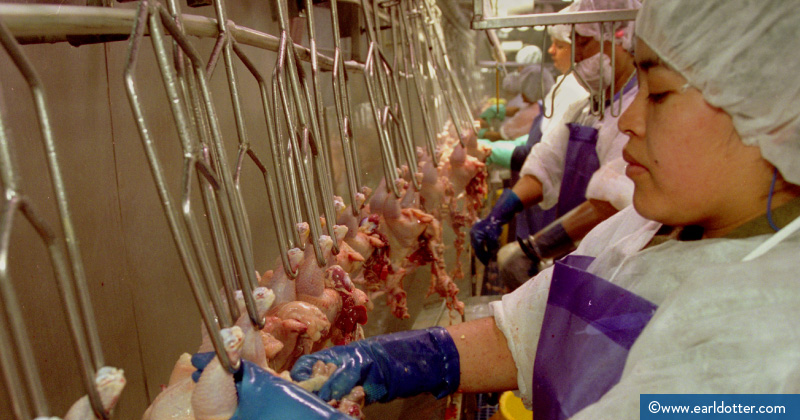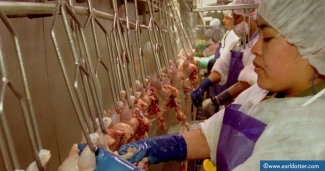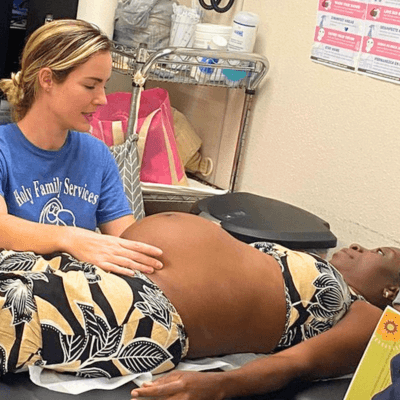We’re not blaming the elderly. We’re not blaming healthcare workers. So why do we accuse essential workers for being sickened and killed by COVID-19?

By Amy K. Liebman, MPA
Director of Environmental and Occupational Health, Migrant Clinicians Network, Salisbury, MD
Each day I watch in utter dismay the increasing numbers of COVID-19 cases among essential workers processing our beef, pork and poultry. Across the US, at least 15,000 workers are infected and over 60 have died from this novel virus. What’s even more disconcerting is that it’s nearly impossible to keep up, as cases and deaths continue to climb.
The cornerstone of the multi-billion dollar meat processing industry are low-paid immigrant workers from countries including Mexico, Guatemala, Haiti and Somalia as well as many African Americans. They labor in plants that churn nearly 24 hours a day in isolated, often rural locations. This includes Maryland’s Delmarva Peninsula where I live. The greater Salisbury metropolitan area recently peaked at #10 on the New York Times list of hotspots for highest daily average for growth rate of cases, mostly the result of new cases from the poultry industry. While its place on the hotspot list has since declined, the disparities of those sickened are striking. In nearby Sussex County, Delaware, home to six chicken processing plants, the COVID-19 positive rate is 742 per 10,000 for Hispanics and 199 per 10,000 for blacks, compared to 45 per 10,000 for whites.
Given the immigrant and minority makeup of this workforce, it’s disturbing to witness the ease at which the industry and politicians blame workers and their lifestyles and even their cultures for contracting COVID-19. A high-ranking Trump administration official recently suggested that infected workers were bringing the virus into processing plants. Many in our own communities easily embrace this line. Perhaps it’s just too hard to blame the community’s primary economic engines. Even our local hospital’s safety officer, a physician, noted in a recent interview, “I don’t think it’s as much their work environment as it’s the fact that they live in a very tight environment. They’ll have six or seven adults living in a very small residence. Unfortunately, they don’t have a lot of money, they have lots of family, and they don’t speak English in many cases.”
While the poverty and crowded living arrangements foster community spread and are important factors to address, it’s a faulty and dangerous response to downplay the workplace when at least 170 plants in 29 states have had one or more workers test positive for COVID-19. The outbreaks have prompted at least 40 processing facilities to temporarily close since the start of the pandemic. These hotspots are not limited to our country. Canada, Germany and Ireland all report COVID-19 hotspots associated with meat-processing facilities.
We do not blame the lifestyles and culture of the elderly in nursing homes as they become victims of this virus. Nor are we questioning the lifestyles of the nearly 200 meat plant inspectors infected with COVID-19, the same virus that has left four inspectors dead. And we recognize why doctors and nurses have fallen ill in the hospitals where they care for sick patients: it’s the workplace, not the home life.
The devasting outbreaks of COVID-19 in meat processing plants expose a crisis in worker safety. Addressing factors that make these workers so vulnerable is critical to safely opening our country back up. It’s also our duty to protect “essential” workers who are risking their lives so we can continue eating.
The industry is built on cheap labor hired to process our meat, working in damp, cold, temperature-controlled and poorly ventilated plants to keep the meat safe. The line speeds, which have dramatically increased over recent years, force workers to labor in close range. It also limits workers from taking needed breaks, and reports of workers donning adult diapers to get them through shifts are both shocking and revealing of an industry that doesn’t take worker health seriously. It’s a grueling job noted for is high rates of injury where employees commonly experience lacerations and repetitive stress ailments. Few have access to paid sick leave, and many cannot afford to miss work when ill, and fear losing their jobs if they do not show up. All these factors combined make these facilities perfect vectors for spreading disease.
More importantly, the Occupational Safety and Health Administration (OSHA), the federal agency responsible for protecting workers, has failed these workers. After the 2009 H1N1 epidemic, OSHA enforced clear and specific Centers for Disease Control and Prevention (CDC) guidance to protect healthcare workers and started writing a standard to protect workers in all industries from infectious disease. But the Trump Administration halted all work on that standard in 2017. Now, OSHA has abdicated its responsibility to protect workers, refusing to mandate new CDC guidance, allowing plants to stay open without requiring any COVID-19 safety precautions. In essence, OSHA has told workers they can either risk infection and possibly death, or not earn an income. While many plants have taken voluntary steps like social distancing, temperature checks and revised leave policies, it’s been too little, too late.
COVID-19 has fostered a massive worker safety crisis, exacerbated by lagging workplace protections. We need our leaders to recognize the essential nature of this work, and the dangers that these workers are putting themselves in to ensure our food systems continue, by immediately requiring extensive workplace protections, testing and contact tracing, increased hazard pay, paid sick leave and health care. It is the least we can do for their critical work.
Like what you see? Amplify our collective voice with a contribution.
Got some good news to share? Contact us on our social media pages above.
Return to the main blog page or sign up for blog updates here.
- Log in to post comments






